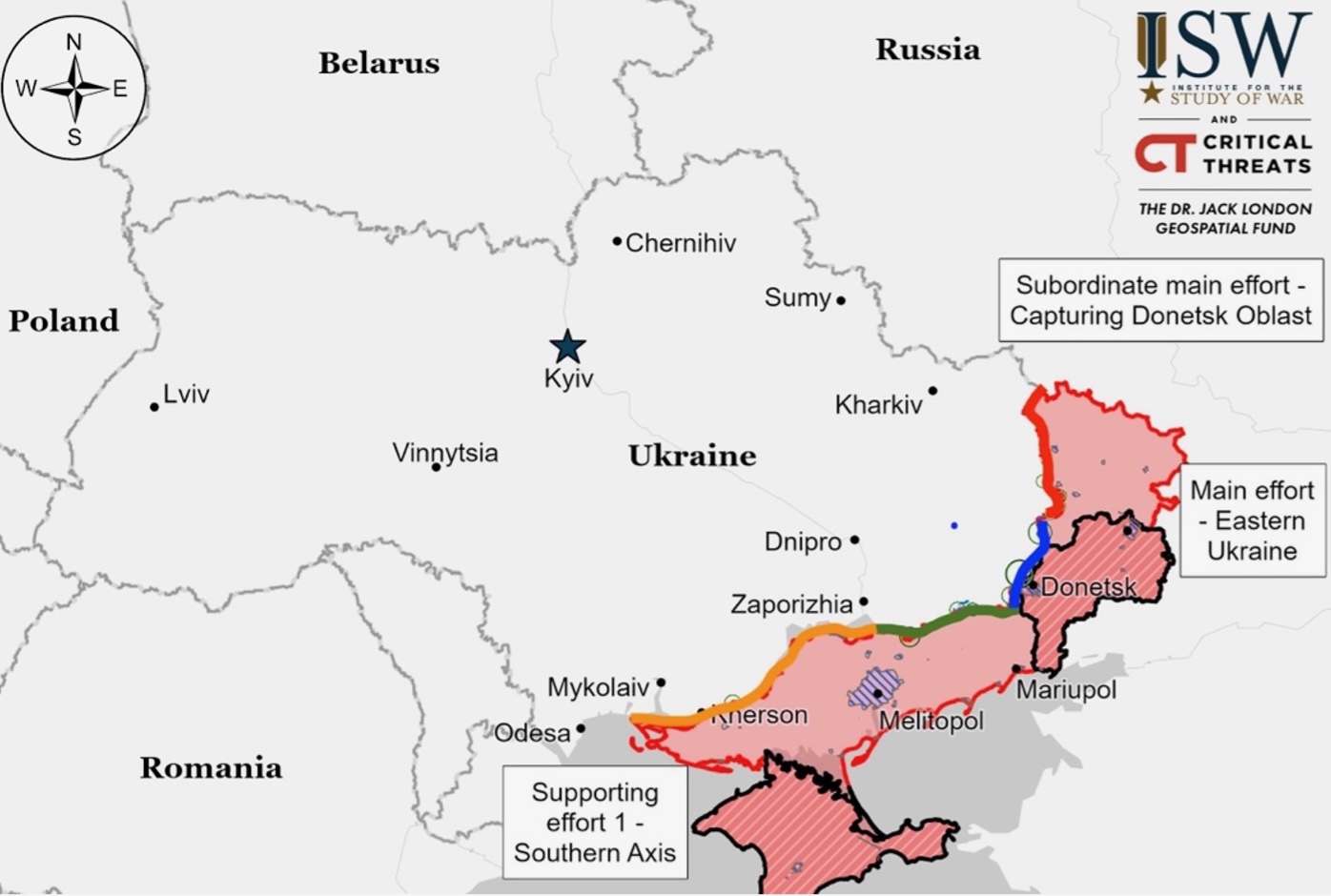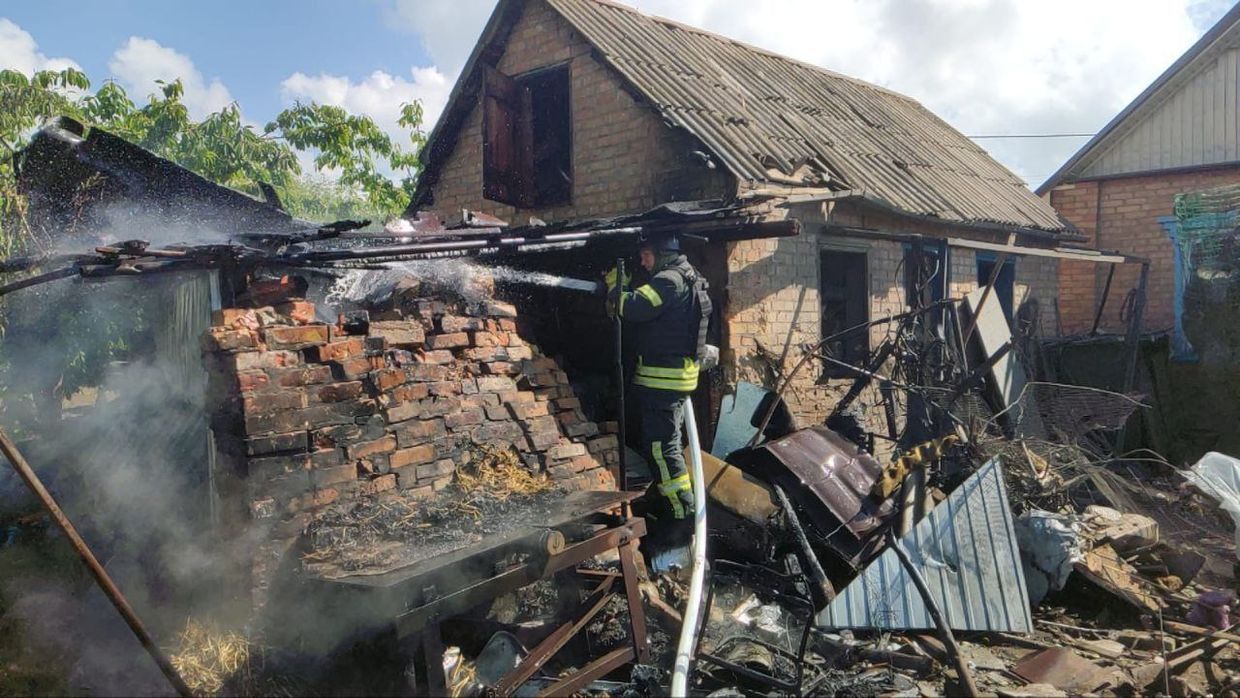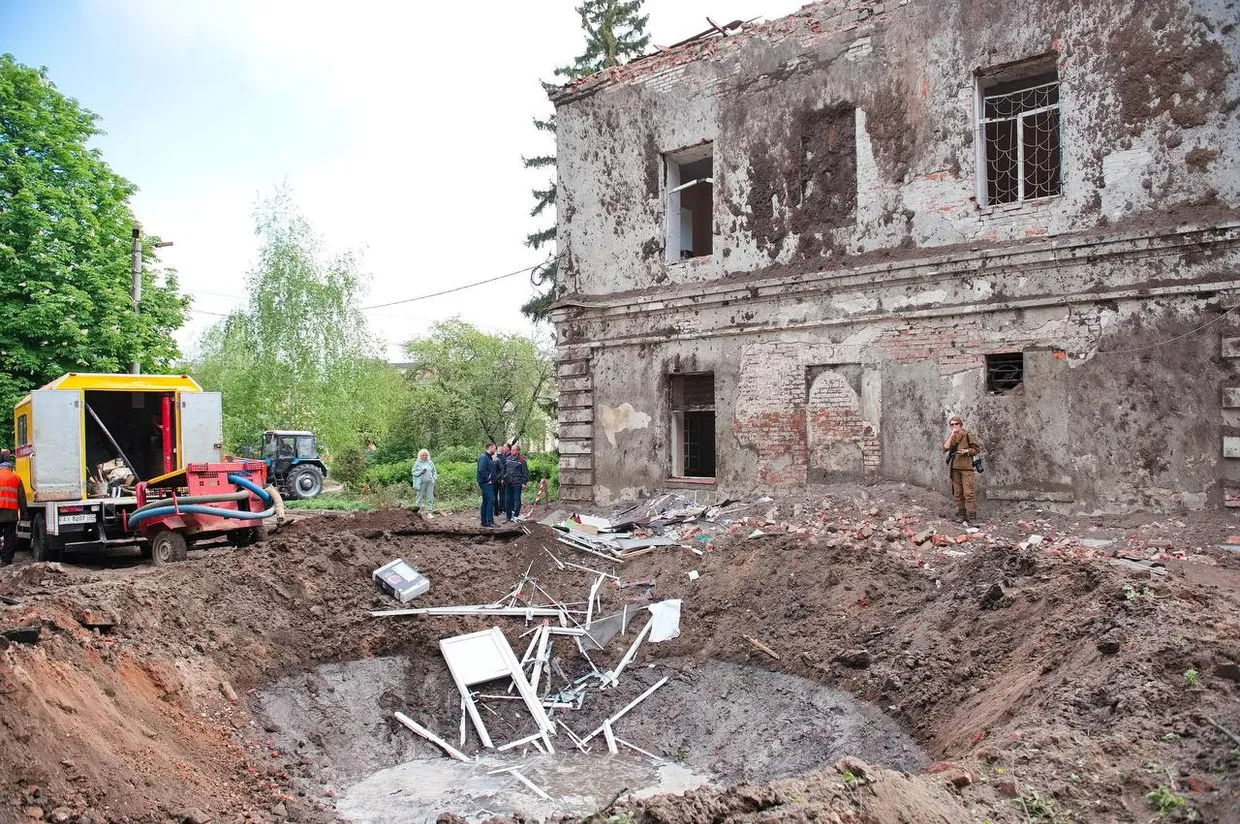Summary of the day: Russian forces have made confirmed advances north of Avdiivka and west of Donetsk City, while also conducting large-scale cruise and ballistic missile strikes against Ukraine. The tempo of their offensive operations is notably higher in the Avdiivka direction than near Chasiv Yar, though an intensification near Chasiv Yar is expected soon due to its operational significance. Despite these advances and the ongoing threat, well-provisioned Ukrainian forces are likely able to prevent operationally significant Russian advances during the anticipated summer offensive. Meanwhile, Ukrainian forces carried out successful drone strikes against Russian targets in Krasnodar Krai. Additionally, the Kremlin is preparing to enhance its hybrid operations against Moldova and continues efforts to increase control over migrant communities in Russia.
What Can I Do To Help Ukraine? This is a question I receive all the time. We at Transform Ukraine are building longer-term housing for internally displaced Ukrainians. Visit Rebuild Ukraine for how you can assist in housing a Ukrainian family displaced by the war.
Beyond Ukraine – March Towards World War
The Kremlin is reportedly escalating its hybrid operations in Moldova. Yevgenia Gutsul, a Kremlin-affiliated governor from Moldova’s Gagauzia region, claimed that Moldovan law enforcement detained her and her advisors upon their arrival at Chisinau airport, following meetings in Russia and Turkey. Although released after brief interrogations, Gutsul alleged that the detentions were part of Moldova’s efforts to humiliate pro-Russian figures. This incident comes amidst broader actions against Kremlin-linked politicians in Moldova, including the confiscation of significant funds, which Gutsul describes as biased. These developments suggest an intensifying conflict between pro-Russian elements in Moldova and the national government, likely fueling further tensions.
The Moldovan government is actively combating Russian disinformation in the autonomous region of Gagauzia. On April 26, the Moldovan Audiovisual Council fined two Gagauzian TV stations, TV-Gagauzia and ATV, 100,000 Moldovan lei ($5,627) each for broadcasting disinformation and hate speech. These stations were found to be promoting divisive symbols and messages that suggested Gagauzia should secede from Moldova and align more closely with Russia. The content included narratives that criticized Moldova’s potential EU and NATO membership as leading to war and loss of sovereignty. These actions reflect ongoing efforts by the Kremlin to use media in Moldova to support its geopolitical agenda, often justifying its aggressive policies by claiming to protect Russian-speaking communities.
Russian peacekeeping forces conducted an unannounced military exercise in Transnistria, a breakaway region of Moldova, which heightened tensions with the Moldovan government. This exercise, which involved simulated repelling of attacks near four settlements on April 23, violated protocols set by the Organization for Security and Cooperation in Europe (OSCE). Moldovan officials criticized the exercise as a provocation and plan to address it in the upcoming Joint Control Commission (JCC) meeting. Transnistria defended the exercise as necessary for maintaining troop readiness. This incident reflects ongoing Russian efforts to use hybrid operations to destabilize Moldova and hinder its EU integration.
Belarusian officials are participating in Russian efforts to intimidate Ukrainian citizens. The head of Belarus’ KGB, Ivan Tertel, claimed at the All-Belarusian People’s Assembly on April 25 that Belarusian volunteers in Ukraine, labeled as terrorists, were being treated at two Kyiv hospitals, including a children’s hospital. Tertel threatened decisive action against what he called “terrorism.” These remarks were taken seriously by Ukrainian authorities, prompting evacuations of the named hospitals due to safety concerns. This action aligns with ongoing Russian tactics of targeting Ukrainian medical facilities and civilians, which violates international law.
Situation On The Land, Sea, and Air in Ukraine
Russian forces have made some tactical advances in Ukraine, particularly north of Avdiivka and near Chasiv Yar, and intensified missile strikes. Despite these moves, Ukrainian forces, bolstered by incoming U.S. security assistance, are expected to hold their defensive lines. Russia aims to prepare the battlefield for a potential larger offensive in late May or June but is unlikely to achieve a significant breakthrough that could overwhelm Ukrainian defenses.
Despite being well-equipped, Ukrainian forces face a significant threat from Russian forces this summer. Russia plans to leverage its numerical advantages in equipment and manpower, despite having outdated military resources and poorly trained troops. Although Russian forces have been less effective overall, they use their quantitative edge to continually pressure Ukrainian defenses. This strategy has enabled some tactical gains for Russia, particularly as delays in Western security assistance have temporarily reduced Ukraine’s qualitative superiority.
Russian forces are adapting their military strategies in Ukraine, incorporating both new technologies and tactical changes, such as the extensive use of glide bombs to support ground operations from safer distances. Despite these innovations, Russian forces still encounter tactical failures that Ukrainian forces can exploit. As U.S. security assistance arrives, enhancing Ukrainian air defense and other capabilities, it is expected that Ukraine will stabilize the frontlines and potentially begin counteroffensive operations by late 2024 or early 2025. Russia, however, continues to adjust its tactics to try and exploit any Ukrainian vulnerabilities before they can adapt.
Ukrainian forces carried out a missile strike on a railway bridge in occupied Zaporizhia Oblast, targeting a location west of Chernihivka, northwest of Melitopol. The strike was confirmed by geolocated footage published.
The 47th Separate Mechanized Brigade of Ukraine refuted an Associated Press report claiming that Ukrainian forces withdrew U.S.-supplied Abrams tanks from the front due to the threat of Russian drones. The brigade affirmed the tanks are effectively supporting infantry on the battlefield and dismissed reports of retreat. The AP had cited U.S. military officials saying that five of the 31 Abrams tanks given to Ukraine in fall 2023 were lost in combat. The brigade emphasized the importance of relying on verified information and declined to discuss the strategic deployment of its forces. The New York Times had previously reported that eight Abrams tanks were either disabled or damaged by Russian forces, but the Ukrainian military has not officially confirmed these figures.

Luhansk Front – Initiative Russia
Donetsk Front – Initiative Russia
Zaporizhia Front – Initiative Russia
Kherson (Dnipro River) Front – Initiative None
Russian forces have reportedly made advances in the area northwest of Svatove, capturing the settlement of Kyslivka. According to Russian milbloggers, the Russian 1st Guards Tank Army broke through Ukrainian defenses and achieved control of Kyslivka, advancing approximately 1.85 kilometers along a key railway line. Additionally, claims suggest that Russian forces have semi-encircled Ukrainian troops near Kotlyarivka, southwest of Kyslivka. However, these claims have not been visually confirmed, and fighting continues in the region including near Berestove and Stelmakhivka.
fFghting persisted in areas southwest of Svatove and around Kreminna without any confirmed changes to the frontlines. Skirmishes occurred near Druzhelyubivka, Novoyehorivka, and Hrekivka southwest of Svatove; around Nevske northwest of Kreminna; near Terny and Zarichne west of Kreminna; and close to the Serebryanske forest and Bilohorivka south of Kreminna. A Ukrainian sergeant reported that Russian forces maintain a significant artillery advantage in these areas, particularly near the Serebryanske forest, although the front is described as “more or less stable.”
There were ongoing limited positional battles northeast of Bakhmut, particularly near Spirne and Vyimka southeast of Siversk, with no confirmed changes to the frontline.
Russian forces pressed their offensive in the Chasiv Yar area without achieving confirmed changes to the frontline. Intense fighting was reported on the eastern outskirts of Chasiv Yar and in nearby forest areas. Russian forces are also reportedly making moves south of the Stupky-Holubovskyi 2 nature reserve, paralleling the T0504 highway. Meanwhile, Ukrainian forces successfully repelled Russian attacks in several locations including Novyi Microraion and near Ivanivske and Klishchiivka.
Russian military operations are currently more intense around Avdiivka than near Chasiv Yar. Despite this, plans are in place to escalate operations near Chasiv Yar soon, aiming to leverage it as a strategic launch point for further offenses. Russian forces have established a significant advantage in the Avdiivka area by deploying a division’s worth of troops, giving them a threefold superiority over Ukrainian forces there. Meanwhile, operations in Chasiv Yar have slowed, with recent Russian efforts focusing on regrouping and reconstituting their forces. However, increased offensive activity is expected in the near future, with potential significant implications for Ukrainian defense lines around key fortress cities like Kostyantynivka and Druzhkivka.
Russian forces have made tactical gains around Avdiivka, advancing into northern Novokalynove and parts of western Ocheretyne, southwestern Solovyove, and near Novobakhmutivka. Milbloggers claim full control of Solovyove, supported by geolocated footage. Although some reports suggest advances into Keramik, no visual evidence confirms this yet. Continued fierce fighting is reported in western Berdychi, with Russian efforts pushing Ukrainian forces westward.
Russian forces have reinforced their positions near Novobakhmutivka and Ocheretyne with additional units aiming to breach Ukrainian defenses. In response, Ukraine has deployed extra reserves and resources to counteract the Russian advantage. Current battles are concentrated around key areas north, northwest, west, and southwest of Avdiivka, with various Russian brigades actively engaged. Ukrainian defense strategies are adjusting to manage the intensified Russian offensive operations in these regions. Meanwhile, in Ocheretyne, a frontline village in Donetsk Oblast, Russian forces breached Ukrainian defenses, confirmed by Khortytsia group spokesperson Nazar Voloshyn. Located northwest of Avdiivka, Ocheretyne has become a focal point of intense battles following its capture by Russia in February. Ukrainian defense forces are actively working to push the enemy out, even as Russian troops employ chemical weapons. The area has seen the concentration of four Russian brigades, prompting Ukrainian defenders to mobilize reserves to stabilize the situation and reclaim control over Ocheretyne.
Russian forces have made a confirmed advance in central Krasnohorivka, west of Donetsk City, moving towards a key traffic circle. While Russian milbloggers report efforts to clear a brick factory in the area, there is no visual confirmation of Russian control within the factory. Fighting continues west of Donetsk City near Heorhiivka and southwest near Paraskoviivka and Pobieda. Russian sources claim full control over Novomykhailivka.
Russian sources reported that their forces made advances near the Donetsk-Zaporizhia Oblast border, claiming a 400-meter advance near Urozhaine and 100 meters near Staromayorske, south of Velyka Novosilka. However, there is no visual confirmation of these claims. The Ukrainian General Staff indicated Russian attacks in the Vuhledar area, as well as near Prechystivka, Urozhaine, and Staromayorske.
Positional engagements persisted in western Donetsk Oblast, particularly near Robotyne and northwest of Verbove, with no confirmed changes to the frontline.
Positional engagements persisted on the east bank of Kherson Oblast, particularly near Krynky. A Russian milblogger noted a minor Ukrainian presence near the Antonivsky roadway bridge.
Ukrainian Civilian Victims Of War
The casualty count of Ukrainian civilians in the past 24 hours:
DEATHS: 1 INJURIES: 20
- Russian attacks on the Nikopol district of Dnipropetrovsk Oblast injured two women, aged 88 and 40. The attacks included 13 drone strikes and five artillery attacks on Nikopol, Myrove, and Pokrovske communities. Damage included two buildings, nine houses, six outbuildings, and several cars, with one outbuilding catching fire, later extinguished by emergency services. An agricultural company and power lines were also affected, leaving 300 people without power.
- A Russian drone attack on a truck in Kharkiv Oblast injured a 52-year-old driver near Vovchansk, close to the Russian border. The driver is hospitalized in serious condition.
- Regional authorities reported that recent Russian attacks in Ukraine’s Kherson, Donetsk, Kharkiv, and Dnipropetrovsk oblasts resulted in one death and 14 injuries. In Kherson Oblast, attacks on the southern city and 13 other settlements damaged two houses, critical infrastructure, and civilian vehicles, leaving one dead and eight injured. In Kharkiv, a psychiatric hospital was struck overnight, injuring a 53-year-old female patient, with 65 people present during the attack.
- In Dnipropetrovsk Oblast, air defenses intercepted 13 of 34 missiles, but energy facilities near Dnipro and Kryvyi Rih were damaged, according to Governor Serhii Lysak. A 39-year-old man was injured and hospitalized in stable condition, causing water supply interruptions in Kryvyi Rih. Later, a 45-year-old man sought medical assistance and was hospitalized, followed by a 59-year-old woman injured in Dnipro during the attack.
 The aftermath of Russian attacks against the Nikopol district
The aftermath of Russian attacks against the Nikopol district
 An image of the truck hit by a Russian FPV drone near Vovchansk
An image of the truck hit by a Russian FPV drone near Vovchansk
 The aftermath of Russia’s overnight missile attack against a psychiatric hospital in Kharkiv
The aftermath of Russia’s overnight missile attack against a psychiatric hospital in Kharkiv
Ukraine News
On the night of April 26 to 27, Russian forces launched a large-scale missile attack against Ukraine, firing 34 missiles, including cruise and ballistic missiles, and notably resuming sea-based Kalibr cruise missile attacks after a hiatus, with Ukrainian defenses intercepting 21 of these missiles. The strikes, which did not employ Shahed drones, caused serious damage to thermal power plants across Ivano-Frankivsk, Lviv, and Dnipropetrovsk oblasts. A significant shift was seen as Russia launched Kalibr missiles from submarines stationed at Novorossiysk, a capability previously exclusive to Sevastopol, reflecting a strategy to mitigate the risk to surface vessels from Ukrainian attacks and signaling the utilization of a substantial stockpile of over 260 Kalibr missiles. Concurrently, Russia’s airstrikes on April 27 targeted Naftogaz Group’s gas infrastructure within the same Ukrainian oblasts, with no reported injuries and assurances of uninterrupted service provision to consumers. The attacks against Naftogaz, which are part of an escalating pattern observed since spring, came after previous strikes in March and April, with company personnel actively managing the consequences.
Ukraine’s President Volodymyr Zelensky warned U.S. House Speaker Mike Johnson in December that Ukraine could only resist Russian aggression until March or April without U.S. support. Following months of congressional blockade since October 2023, a $61 billion aid package for Ukraine was finally passed and signed by President Biden in April. Speaker Johnson, who had previously linked foreign aid to border security, shifted his stance, influenced by arguments that aiding Ukraine was cost-effective for U.S. interests against the Russia-China-Iran axis. Despite Politico’s report suggesting the December meeting influenced Johnson, he later stated that the meeting did not alter the legislative conditions for the aid package.
Volodymyr Maibozhenko, former head of the Brovary District Military Administration in Kyiv Oblast, was relieved of his duties following a car accident on April 26 where he was reportedly driving intoxicated, injuring four people, including a child. He has been detained and faces a potential three to eight-year prison term. Maibozhenko ran a red light and struck pedestrians, with an alcohol test confirming intoxication. The injured parties are currently hospitalized, with two in serious condition.
Ukraine’s Allies
Australia announced a new aid package of 100 million Australian dollars ($65 million) for Ukraine, following talks between Prime Minister Denys Shmyhal and Australian Defense Minister Richard Marles in Lviv. This brings Australia’s total military support to Ukraine to 880 million Australian dollars ($575 million). Half of the package will go towards Man-Portable Air Defense Systems (MANPADS), with over 30 million Australian dollars ($19.6 million) allocated to an international drone coalition to enhance Ukraine’s unmanned aerial vehicles (UAVs). Marles highlighted Australia’s contribution of world-leading drone technology and air-to-ground precision munitions. Shmyhal expressed gratitude for Australia’s solidarity and thanked Marles for his support.
Slovak activists raised 3.9 million euros ($4 million) in 12 days for the Czech ammunition initiative for Ukraine, after Slovakia’s government declined to participate. The campaign, “Ammunition for Ukraine,” aims to address Ukraine’s critical ammunition shortage. Several countries, including Belgium, the Netherlands, Germany, and others, have contributed funds to deliver up to 1.5 million rounds to Kyiv. Over 60,000 Slovaks donated to the initiative in response to their government’s stance. While delivery timelines are not confirmed, the first batches could be sent as early as June.
Russia News
On the night of April 26 to 27, Ukrainian forces launched drone strikes on a Russian military airfield and two oil refineries in Krasnodar Krai. The targeted facilities included the Kushchyovskaya airfield and the Ilskiy and Slavyansk oil refineries, resulting in significant damage to refinery equipment and temporary shutdowns. While the Krasnodar Krai Governor reported minimal harm, the Slavyansk Oil Refinery Security Director noted operational halts and potential unseen damages, with TASS reporting a substantial fire at the Slavyansk facility. Confirming interception of Ukrainian drones, Governor Veniamin Kondratyev claimed no severe damages. These strikes are part of Ukraine’s campaign to disrupt Russian oil capabilities, drawing U.S. concern over global energy market impacts. President Zelensky defended the strikes as legitimate retaliation against Russian aggression.
Ukraine’s military intelligence agency, HUR, in collaboration with the 15th Separate Artillery Reconnaissance Brigade, successfully targeted a Russian Podlet-K1 radar station on April 27. The attack damaged the radar’s antenna post and diesel generator. The Podlet-K1, a mobile radar system valued at approximately $5 million, can detect up to 200 air targets, particularly at low altitudes. Introduced to the Russian military in 2015, it plays a crucial role in detecting targets for S-300/S-400 anti-aircraft missile systems.
Dmitry Medvedev, Russia’s Security Council deputy chairman, warned on April 27 that Russia could seize assets and property of U.S. individuals in Russia if the U.S. confiscates Russian sovereign assets under the REPO Act. The U.S. Congress approved the act, allowing President Biden’s administration to seize Russian assets in American banks. Medvedev claimed Russia may retaliate by targeting private U.S. individuals’ assets within Russian jurisdiction. While Congress passed the bill, Biden’s plans remain unclear. Moscow threatened to lower diplomatic relations if assets are seized, amid deteriorating U.S.-Russia relations since Ukraine’s invasion.
A Tajik citizen, Dzhumakhon Kurbonov, was detained in Moscow, suspected of financing, and providing telecommunications support for the March 22 terrorist attack at Crocus City Hall. The court has ordered his detention until at least May 22, following a closed-door hearing. This incident, which resulted in at least 145 deaths and over 500 injuries, was claimed by ISIS. Notably, a significant number of the suspects detained are from Tajikistan, with several showing signs of abuse. The attack has sparked xenophobic backlash and fear among Central Asians in Russia, where many reside or work seasonally, significantly contributing to Tajikistan’s economy through remittances.
The Russian government is taking steps to tighten control over migrant communities. A new bill introduced by the State Duma aims to modernize migration legislation to enhance national security. This includes a deportation regime for migrants without valid residency grounds and restrictions on their ability to purchase property, open bank accounts, or marry. Additionally, Russian universities will now exclusively administer Russian language certification tests, making it harder for migrants to access certain jobs and services. At the same time, the government is selectively aiding some migrants in obtaining citizenship, particularly those who align with Russia’s ideological goals in its war efforts, as evidenced by a joint project between RT and the Ministry of Internal Affairs assisting a Kyrgyz migrant with obtaining Russian citizenship. This dual approach highlights a broader strategy of selective empowerment amidst increased restrictions.
According to the Wall Street Journal, U.S. intelligence sources suggest Russian President Vladimir Putin likely did not directly order the murder of opposition leader Alexei Navalny, who died on February 16 in a Russian penal colony. This view, reportedly shared by the CIA, State Department intelligence, and the Office of the Director of National Intelligence, suggests Navalny’s death may not have been a direct Kremlin order but does not absolve Putin of responsibility. The conclusion is based on classified intelligence and contextual factors, including the political landscape around Putin’s re-election. European intelligence officials and Navalny’s associate, Leonid Volkov, express skepticism, doubting Navalny could have been harmed without Putin’s knowledge. Navalny’s death led to increased Western sanctions and a crackdown on dissent in Russia.
Russian Mobilization and Defense Industrial Base
Tula Oblast Governor Alexei Dyumin met with the Russian 106th Airborne Division in Tula City, providing them with new uniforms and equipment. This meeting underscores ongoing sponsorship of military units by Russian regional authorities, with Dyumin specifically identified as a patron of this division.
Kalashnikov Concern, part of the Russian state-owned Rostec, announced that it has been supplying Russian forces in Ukraine with BMP-3 infantry fighting vehicles equipped with the 4S24 dynamic protection system. This system is designed to protect the vehicles from grenades and anti-tank guided missile strikes. The company first announced this new protection system in 2023 and has been distributing the upgraded vehicles since early 2024.
Russian Narratives and Propaganda
Russian officials are framing Ukrainian strikes on military targets in occupied Ukraine and Russia as “terrorist attacks,” threatening escalation to intimidate Ukraine and the West. Admiral Tony Radakin, UK Defense Chief of Staff, indicated on April 25 that Ukrainian capabilities for long-range strikes are expected to increase, which Russia labeled as terrorism. This tactic by Russia seeks to deter Western support for Ukraine by stoking fears of escalation and bolstering domestic support for the conflict.
Source Materials
Institute for the Study of War – understandingwar.org
The Kyiv Independent – kyivindependent.com
Kyiv Post – kyivpost.com
